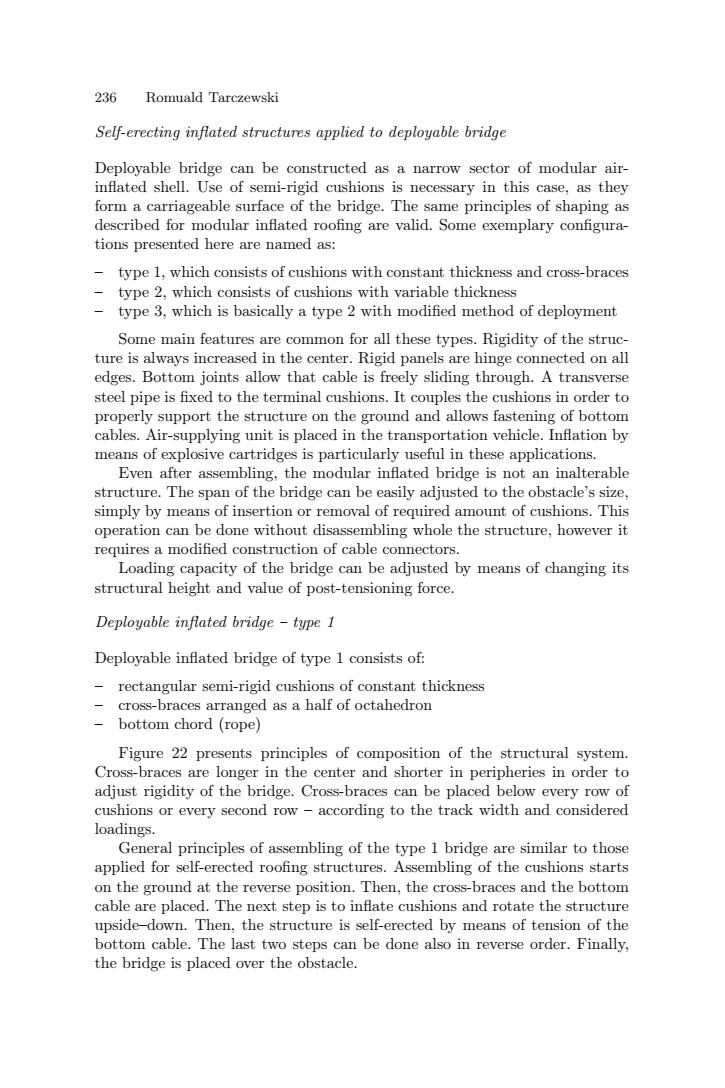正在加载图片...

236 Romuald Tarczewski Self-erecting inflated structures applied to deployable bridge Deployable bridge can be constructed as a narrow sector of modular air- inflated shell.Use of semi-rigid cushions is necessary in this case,as they form a carriageable surface of the bridge.The same principles of shaping as described for modular inflated roofing are valid.Some exemplary configura- tions presented here are named as: type 1,which consists of cushions with constant thickness and cross-braces type 2,which consists of cushions with variable thickness type 3,which is basically a type 2 with modified method of deployment Some main features are common for all these types.Rigidity of the struc- ture is always increased in the center.Rigid panels are hinge connected on all edges.Bottom joints allow that cable is freely sliding through.A transverse steel pipe is fixed to the terminal cushions.It couples the cushions in order to properly support the structure on the ground and allows fastening of bottom cables.Air-supplying unit is placed in the transportation vehicle.Inflation by means of explosive cartridges is particularly useful in these applications. Even after assembling,the modular inflated bridge is not an inalterable structure.The span of the bridge can be easily adjusted to the obstacle's size, simply by means of insertion or removal of required amount of cushions.This operation can be done without disassembling whole the structure,however it requires a modified construction of cable connectors. Loading capacity of the bridge can be adjusted by means of changing its structural height and value of post-tensioning force. Deployable inflated bridge-type 1 Deployable inflated bridge of type 1 consists of: 一 rectangular semi-rigid cushions of constant thickness cross-braces arranged as a half of octahedron bottom chord (rope) Figure 22 presents principles of composition of the structural system. Cross-braces are longer in the center and shorter in peripheries in order to adjust rigidity of the bridge.Cross-braces can be placed below every row of cushions or every second row-according to the track width and considered loadings. General principles of assembling of the type 1 bridge are similar to those applied for self-erected roofing structures.Assembling of the cushions starts on the ground at the reverse position.Then,the cross-braces and the bottom cable are placed.The next step is to inflate cushions and rotate the structure upside-down.Then,the structure is self-erected by means of tension of the bottom cable.The last two steps can be done also in reverse order.Finally, the bridge is placed over the obstacle.236 Romuald Tarczewski Self-erecting inflated structures applied to deployable bridge Deployable bridge can be constructed as a narrow sector of modular airinflated shell. Use of semi-rigid cushions is necessary in this case, as they form a carriageable surface of the bridge. The same principles of shaping as described for modular inflated roofing are valid. Some exemplary configurations presented here are named as: – type 1, which consists of cushions with constant thickness and cross-braces – type 2, which consists of cushions with variable thickness – type 3, which is basically a type 2 with modified method of deployment Some main features are common for all these types. Rigidity of the structure is always increased in the center. Rigid panels are hinge connected on all edges. Bottom joints allow that cable is freely sliding through. A transverse steel pipe is fixed to the terminal cushions. It couples the cushions in order to properly support the structure on the ground and allows fastening of bottom cables. Air-supplying unit is placed in the transportation vehicle. Inflation by means of explosive cartridges is particularly useful in these applications. Even after assembling, the modular inflated bridge is not an inalterable structure. The span of the bridge can be easily adjusted to the obstacle’s size, simply by means of insertion or removal of required amount of cushions. This operation can be done without disassembling whole the structure, however it requires a modified construction of cable connectors. Loading capacity of the bridge can be adjusted by means of changing its structural height and value of post-tensioning force. Deployable inflated bridge – type 1 Deployable inflated bridge of type 1 consists of: – rectangular semi-rigid cushions of constant thickness – cross-braces arranged as a half of octahedron – bottom chord (rope) Figure 22 presents principles of composition of the structural system. Cross-braces are longer in the center and shorter in peripheries in order to adjust rigidity of the bridge. Cross-braces can be placed below every row of cushions or every second row – according to the track width and considered loadings. General principles of assembling of the type 1 bridge are similar to those applied for self-erected roofing structures. Assembling of the cushions starts on the ground at the reverse position. Then, the cross-braces and the bottom cable are placed. The next step is to inflate cushions and rotate the structure upside–down. Then, the structure is self-erected by means of tension of the bottom cable. The last two steps can be done also in reverse order. Finally, the bridge is placed over the obstacle